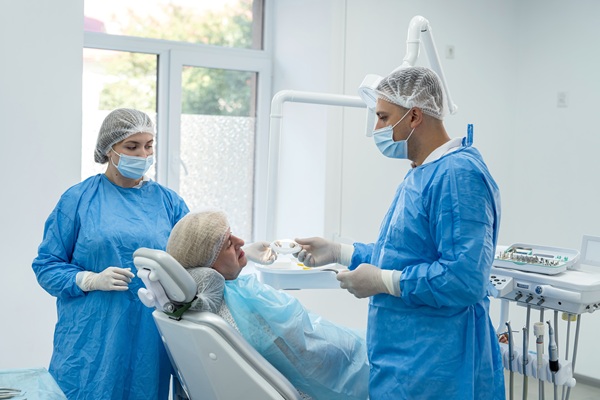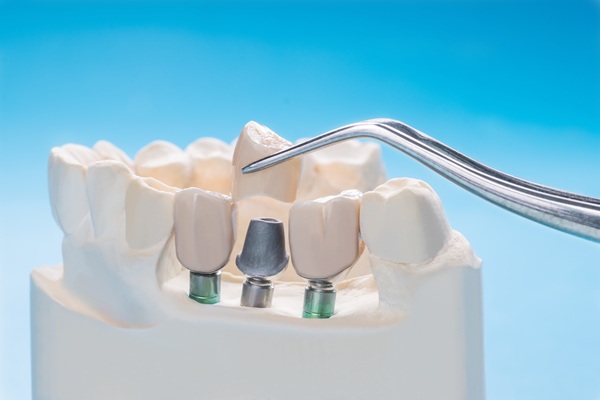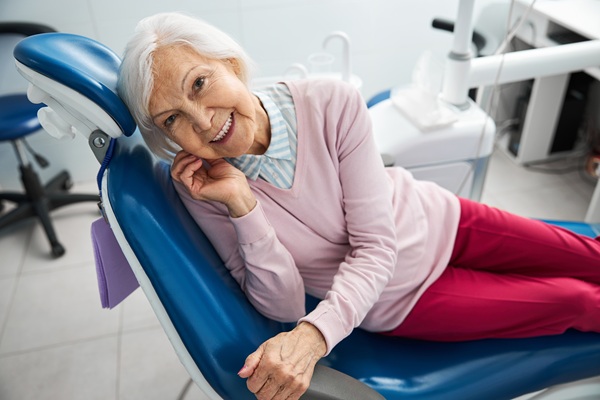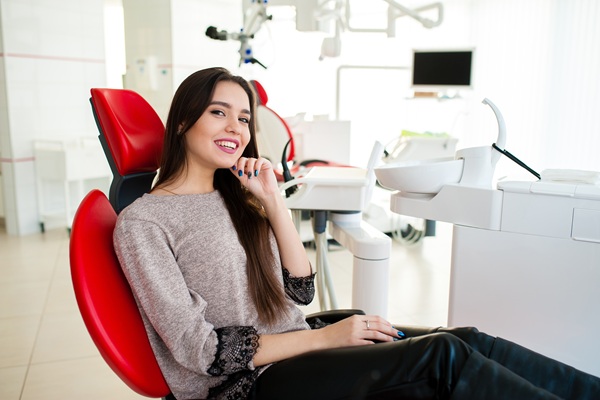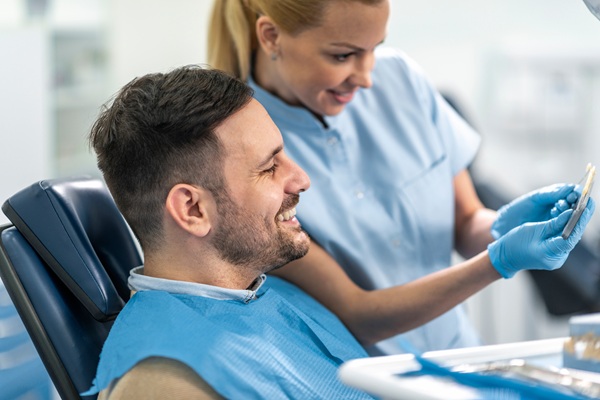
Guided Bone RegenerationWoodland Hills, CA
Guided bone regeneration is a surgical procedure that uses barrier membranes to promote bone growth and regeneration. These barrier membranes direct the growth of new bone and gingival tissue where there are insufficient volumes or dimensions of bone or gingiva. Guided bone regeneration focuses on the development of hard tissues and the soft tissues of the periodontal attachment.
Guided bone regeneration can be essential for proper function, aesthetics, and prosthetic restoration. We can help determine if this procedure is right for you. Call us today at (818) 703-7733 to schedule an appointment or learn more about our services.
Understanding Guided Bone Regeneration
Before we can place dental implants, we must make sure there is an adequate amount of horizontal or vertical bone in the implant sites. Otherwise, the dental implant will not receive the proper support. A ridge augmentation technique is often required to regenerate enough bone to successfully place an implant. Guided bone regeneration is just one type of ridge augmentation technique.
As mentioned earlier on this page, guided bone regeneration is a surgical procedure that uses barrier membranes. They may or may not be used with particulate bone grafts or bone substitutes. Osseous regeneration by guided bone regeneration depends on if and how the pluripotential and osteogenic cells migrate to the bone defect site, along with the exclusion of cells impeding bone formation.
To successfully regenerate a bone defect, "the rate of osteogenesis extending inward from the adjacent boney margins must exceed the rate of fibrogenesis growing in from the surrounding soft tissue." It is often difficult to predict how effective a ridge augmentation may be. A successful guided bone regeneration must meet four different criteria:
- Exclusion of epithelium and connective tissue
- Space maintenance
- Stability of the fibrin clot
- Primary wound closure
Once a guided bone regeneration procedure has been completed, bone regeneration will follow a certain sequence of events. The graft material/barrier-created space will fill with the blood clot, releasing growth factors and cytokines to attract neutrophils and macrophages within the first 24 hours after the bone has been grafted. The body will then absorb the clot and replace it with granulation tissue rich in new blood vessels. These blood vessels may transport nutrients and mesenchymal stem cells, which may contribute to osteoid formation.
The osteoid, once mineralized, forms woven bone, later serving as "a template for the apposition of lamellar bone." Primary sponge work is transformed to eventually "constitute both compact and reticular bone with mature bone marrow." This all occurs three to four months after surgery.
Steps to a Successful Guided Bone Regeneration
According to an article in Chairside Magazine, up to 40% of dental implant sites require guided bone regeneration as a necessary part of the patient's rehabilitation process. There are certain factors and principles that a periodontist must adhere to for a successful implant placement. If the patient has a deficient bony ridge, for instance, then the implant's function, support, and aesthetics may all become compromised.
A successful bone graft requires the "passage of various cellular components from the surrounding recipient site's bony walls and vascular components into the developing graft site." It is more challenging for angiogenesis and cells to migrate to the outer limits of the particulate graft when the distance between these bony surfaces and the peripheral graft components is larger. As such, bony defects should be treated "according to the type of defect and the amount of bone growth required."
To begin the bone regeneration process, the periodontist must first identify both ideal and nonideal cases for the surgery. To do so, they may use cone-beam computed tomography (CBCT) imaging and interactive CBCT treatment planning. Bony defects may be classified as small depressions, concavity defects, convex/straight bone deficiencies, vertical (height) defects, or buccal-lingual defects. Once the periodontist has reviewed the patient's teeth, they will move onto flap design and incision.
It is ideal to gain complete access to the surgical site without compromising the surrounding tissue's integrity. As such, planning the flap design and incision is of the utmost importance. Irregular incisions may lead to maceration of the flap, compromising the primary blood supply source. Afterward, the periodontist will move onto reflection and release of the tissue. During tissue reflection, any underlying bone is scraped with a bone curette to remove any tissue. The flap must also have complete release of tension to prevent incision line opening.
Preparing the recipient site involves soft-tissue removal (upon which the periodontist removes all soft-tissue remnants from the bony recipient site) and decortication (upon which the periodontist creates pilot holes into the cortical bone, initiating the regional acceleratory phenomenon). Then comes space maintenance, which involves tenting screws, and placement of the bone graft, which may involve an autograft (bone graft using one's own bone) or allograft (bone graft using donor bone). Finally, the periodontist will select and place the barrier membrane and ensure proper closure.
Call us Today
If you need dental implants, you may also need a guided bone regeneration procedure. We at Brighton Periodontal & Implant Dental Group can help. Call us today at (818) 703-7733 to schedule an appointment or learn more about our services.
Frequently Asked Questions
Can I eat after my guided bone regeneration procedure?
Avoid eating until the anesthesia has worn off completely, as you may bite and damage your lips, cheek, or tongue. It is not uncommon to experience some discomfort when the anesthesia wears off; however, this is easily manageable with either over-the-counter or prescribed painkillers. Avoid taking aspirin, and only take as much medicine as you are directed to.
Is it normal to experience swelling after a guided bone regeneration procedure?
Yes, this is completely natural. You may also experience chapped lips or a bruising of the lips or cheek area. Using an ice pack for 20 minutes at a time can help during the first 24-48 hours after surgery. Try to keep your head elevated above your heart. The worst of the swelling should subside after the third day. If you are experiencing any major swelling, contact us immediately.
What should I eat after my guided bone regeneration procedure?
Limit yourself to a soft food diet until your mouth has completely healed, and make sure to avoid the surgical area(s) while chewing. Chew on the opposite side of the mouth, and do not bite into food if the procedure was performed at the front of the mouth. You should not eat sticky, hard, spicy, or acidic foods while healing. Avoid alcohol and tobacco.
Can guided bone regeneration treat periodontal disease?
Yes. Traditionally, gum disease has been treated by eliminating any pockets, trimming away the infected tissue, and recontouring the uneven bone. Guided bone regeneration, also known as guided tissue regeneration, is a more advanced technique that, along with stabilizing endangered teeth, can prepare the jaw for dental implants.
What are some of the benefits of guided bone regeneration?
As mentioned above, guided bone regeneration stabilizes endangered teeth and prepares the jaw for dental implants. However, it can also improve natural aesthetics and, as the name suggests, promote bone regeneration.
Contact Us
Brighton Periodontal & Implant Dental Group is located at
6325 Topanga Canyon Boulevard Suite 433
Woodland
Hills, CA
91367
